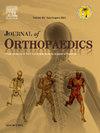Can bioactive glass replace bone grafts after curettage of benign bone Tumors? A systematic review and meta-analysis of randomized controlled trials
IF 1.5
Q3 ORTHOPEDICS
引用次数: 0
Abstract
Background and purpose
Curettage followed by autografts or allografts has been the preferred method for treating benign bone tumors. However, the development of synthetic substances, such as bioactive glass (BAG), has prompted interest in the medical community. This meta-analysis of randomized controlled trial (RCTs) aimed to compare the adverse event rates between BAG and autograft or allograft following curettage for benign bone tumors.
Methods
We searched PubMed, EMBASE, and Cochrane Central for RCTs comparing BAG versus autograft or allograft after curettage for benign bone tumors. The primary endpoint was tumor recurrence. Secondary endpoints included rates of overall complications, mild complications, and reoperations. Risk ratios (RRs) with 95 % CIs were pooled across trials.
Results
Four RCTs encompassing 156 patients were included, with 80 (51.3 %) receiving BAG. The most common lesions were enchondromas (24.4 %) and aneurysmal bone cysts (21.8 %). Recurrence rates were comparable between the BAG group (18.7 %) and the bone grafts (21.0 %) group (RR 0.91; 95 % CI 0.52 to 1.61; p = 0.75; I2: 0 %). Reoperation (RR 1.53; 95 % CI 0.64 to 3.66; p = 0.34; I2 = 0 %), overall complications (RR 0.72; 95 % CI 0.46 to 1.13; p = 0.15; I2 = 0 %), and mild complications (RR 0.54; 95 % CI 0.16 to 1.86; p = 0.33; I2 = 21 %) were also comparable. Longer follow-up subanalysis showed analogous results.
Conclusions
BAG appears as effective as autografts or allografts regarding recurrence, reoperation, and complication rates after curettage of benign bone tumors. Larger RCTs with more standardized approaches are needed for validation.
良性骨肿瘤刮除后生物活性玻璃能代替骨移植物吗?随机对照试验的系统回顾和荟萃分析
背景与目的自体骨移植或同种异体骨移植是治疗良性骨肿瘤的首选方法。然而,合成物质的发展,如生物活性玻璃(BAG),引起了医学界的兴趣。这项随机对照试验(RCTs)的荟萃分析旨在比较良性骨肿瘤刮除后BAG与自体移植物或同种异体移植物的不良事件发生率。方法我们检索PubMed、EMBASE和Cochrane Central,比较良性骨肿瘤刮除后BAG与自体移植物或同种异体移植物的rct。主要终点为肿瘤复发。次要终点包括总并发症、轻度并发症和再手术率。所有试验中95% ci的风险比(rr)被汇总。结果纳入4项随机对照试验,共156例患者,其中80例(51.3%)接受BAG治疗。最常见的病变是内生瘤(24.4%)和动脉瘤性骨囊肿(21.8%)。BAG组(18.7%)和骨移植组(21.0%)的复发率相当(RR 0.91;95% CI 0.52 ~ 1.61;p = 0.75;I2: 0%)。再手术(RR 1.53;95% CI 0.64 ~ 3.66;p = 0.34;I2 = 0%),总并发症(RR 0.72;95% CI 0.46 - 1.13;p = 0.15;I2 = 0%),轻度并发症(RR 0.54;95% CI 0.16 ~ 1.86;p = 0.33;I2 = 21%)也具有可比性。较长时间的随访亚分析显示了类似的结果。结论在良性骨肿瘤刮除后的复发率、再手术率和并发症发生率方面,自体骨移植与同种异体骨移植效果相当。需要更大的随机对照试验和更标准化的方法来验证。
本文章由计算机程序翻译,如有差异,请以英文原文为准。
求助全文
约1分钟内获得全文
求助全文
来源期刊

Journal of orthopaedics
ORTHOPEDICS-
CiteScore
3.50
自引率
6.70%
发文量
202
审稿时长
56 days
期刊介绍:
Journal of Orthopaedics aims to be a leading journal in orthopaedics and contribute towards the improvement of quality of orthopedic health care. The journal publishes original research work and review articles related to different aspects of orthopaedics including Arthroplasty, Arthroscopy, Sports Medicine, Trauma, Spine and Spinal deformities, Pediatric orthopaedics, limb reconstruction procedures, hand surgery, and orthopaedic oncology. It also publishes articles on continuing education, health-related information, case reports and letters to the editor. It is requested to note that the journal has an international readership and all submissions should be aimed at specifying something about the setting in which the work was conducted. Authors must also provide any specific reasons for the research and also provide an elaborate description of the results.
 求助内容:
求助内容: 应助结果提醒方式:
应助结果提醒方式:


